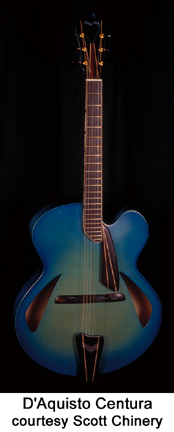
|
|
|
![]() |
 D'AQUISTO D'AQUISTO | | Instruments previously built in Huntington, NY, and Greenport, NY, between 1965 and 1995. | Master Luthier James L. D'Aquisto (1935-1995) met John D'Angelico around 1953. At the early age of seventeen, D'Aquisto became D'Angelico's apprentice, and by 1959 was handling the decorative procedures and other lutherie jobs. When D'Angelico had a falling out with another member of the shop during the move of the business, D'Aquisto began doing actual building and shaping work. This lutherie work continued until the time of D'Angelico's death in 1964. The loss of D'Angelico in 1964 not only affected D'Aquisto personally, but professionally. Although he took over the business and shop with the encouragement of D'Angelico's brother, business under his own trademark started slowly. D'Aquisto continued to work in D'Angelico's shop repairing instruments at the last address - 37 Kenmare Street, New York City, NY. Finally, one year after D'Angelico's death, D'Aquisto summoned the nerve to build a guitar with the D'Aquisto inlay on the headpiece.
In 1965, D'Aquisto moved his shop to Huntington, NY, and sold his first instrument, styled after a D'Angelico New Yorker. Most of D'Aquisto's traditional design instruments are styled after John D'Angelico's Excel and New Yorker, with D'Aquisto adding refinements and improvements. D'Aquisto set up a deal with the Swedish-based Hagstrom company to produce guitars based on his designs in 1968, and the Ampeg company was one of the U.S. distributors. In 1973, D'Aquisto relocated his business once again, this time setting up shop in Farmingdale, NY. He produced his first flattop guitar in 1975, and his first solid body electric one year later. The Fender Musical Instrument Corporation produced a number of D'Aquisto-designed guitars beginning in the 1980s, and two models in the Designer series (D'Aquisto Ultra and Deluxe) are still in production at the Fender USA Custom shop. In the late 1980s, D'Aquisto again moved his shop to Greenport, NY, and continued to produce instruments from that location. In 1987, D'Aquisto broke away from archtop design tradition when he debuted the Avant Garde. The Excel and New Yorker style models were discontinued in 1991, as D'Aquisto concentrated on creating more forward-looking and advanced archtops. In 1994, models such as the Solo with four soundholes (only nine built), and Centura models were introduced. James L. D'Aquisto passed away in April, 1995. Source: Paul William Schmidt, Acquired of the Angels. | | | ACOUSTIC |
|
| Copyright ©2009 Blue Book Publications, Inc. All Rights Reserved.
|

 D'AQUISTO
D'AQUISTO